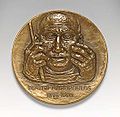William Zorach
William Zorach | |
|---|---|
 William Zorach circa 1917, photographed by Man Ray | |
| Born | Zorach Gorfinkel February 28, 1889 Jurbarkas, Lithuania, Russian Empire |
| Died | November 15, 1966 (aged 77) Bath, Maine, U.S. |
| Known for | Sculpture, painting, printmaking |
| Spouse | |
| Elected | American Academy of Arts and Letters (1953) |
William Zorach (February 28, 1889 – November 15, 1966)
He is the husband of
Early life
Zorach Gorfinkel was born in 1889 into a
Career
While in Paris, Zorach met Marguerite Thompson (1887–1968), an art student and fellow American, whom he married on December 24, 1912, in New York City.[6] The couple adopted his original given name, Zorach, as a common surname. Zorach and his wife returned to America where they continued to experiment with different media.[5] In 1913, works by both Zorach and Marguerite, were included in the now famous Armory Show, introducing his work to the general public as well as art critics and collectors.[7] Both William and Marguerite were heavily influenced by cubism and fauvism. They are credited as being among the premier artists to introduce European styles to American modernism.[5] During the next seven years, Zorach established himself as a painter, frequently displaying his paintings in gallery shows as venues such as the Society of Independent Artists and the Whitney Studio Club.[8] While Marguerite began to experiment with textiles and created large, fine art tapestries and hooked rugs, William began to experiment with sculpture, which would become his primary medium.[5]

In 1915, William and Marguerite started their family with the birth of their son, Tessim.[1] Their daughter, Dahlov Ipcar, was born in 1917, and would later also work as an artist.[5] While the Zorach family spent their winters in New York, their summers were divided between New Hampshire and Massachusetts.[5] Notably, they spent a few summers in Plainfield, New Hampshire at the Cornish Art Colony, renting Echo Farm which was owned by their friend and fellow artist Henry Fitch Taylor. It was here that their daughter was born, all the while producing various prints depicting country life.[9] He was also a member of the Provincetown Printers art colony in Massachusetts.[10]
In 1923, the Zorach family purchased a farm on Georgetown Island, Maine where they resided, worked, and entertained guests.[5] Zorach was elected to the American Academy of Arts and Letters in 1953.[11]
Works
Zorach's works can be found in numerous private, corporate, and public collections across the country including such acclaimed locales as the
-
Puma, in the National Gallery of Art
-
Puma
-
Moses
-
Dimitri Mitropoulos, International Music Competition Medal
-
Brooklyn Museum - Tree - Yosemite - William Zorach - overall
-
Brooklyn Museum - Skiff in Waves (recto) and Figures in Landscape (verso) - Marguerite Thompson Zorach - framed
-
New Horizons. Bronze sculpture, 1951, approximately 42 inches high.
-
William Zorach, Floating Figure. 1922. Bronze. High Museum of Art, Atlanta, Georgia.
-
New York Harbor (1923), The Phillips Collection
References
- ^ a b "William Zorach". Encyclopædia Britannica. Retrieved October 22, 2009.
- ^ Milwaukee Art Center (1976). From Foreign Shores: Three Centuries of Art by Foreign Born American Masters. Milwaukee: Milwaukee Art Center.
- ^ Hoopes, Donelson F. (1968). William Zorach. Brooklyn: Brooklyn Museum.
- ^ Wingert, Paul S. (1938). The Sculpture of William Zorach. New York: Pitman Publishing Corporation. p. 10.
- ^ a b c d e f g Hanson, Jayna. "A Finding Aid to the Zorach Family Papers, 1900–1987, in the Archives of American Art". Archives of American Art, Smithsonian Institution. Retrieved July 29, 2011.
- ^ "Marguerite Thompson Zorach (1887–1968)". Hollis Taggart Galleries. 2008. Archived from the original on October 13, 2012.
- ^ Wingert, Paul S. (1938). The Sculpture of William Zorach. New York: Pitman Publishing Corporation. p. 12.
- ^ Wingert, Paul S. (1938). The Sculpture of William Zorach. New York: Pitman Publishing Corporation.
- ^ "Impressionist & Modern Art – Sale 14PT03 – Lot 88 – Doyle New York". www.doylenewyork.com. Retrieved February 28, 2016.
- ^ "Provincetown Printers/A Woodcut Tradition". Smithsonian Institution. Retrieved February 2, 2017.
- ^ "Deceased Members". American Academy of Arts and Letters. Archived from the original on July 26, 2011. Retrieved July 30, 2011.
- ^ "Inventory". wiscassetbaygallery.com.
- ^ "William Zorach". Olympedia. Retrieved August 8, 2020.
External links
- Official website run by some of Zorach's grandchildren, dedicated to the work of their grandparents.
- "To Be Modern: The Origins of Marguerite and William Zorach's Creative Partnership, 1911–1922", Jessica Nicoll, Portland Museum of Art
- "Works of William Zorach" at the Wiscasset Bay Gallery
- swope.org
- ilovefiguresculpture.com
- Biographies on art.com: short, long
- William Zorach at IMDb









